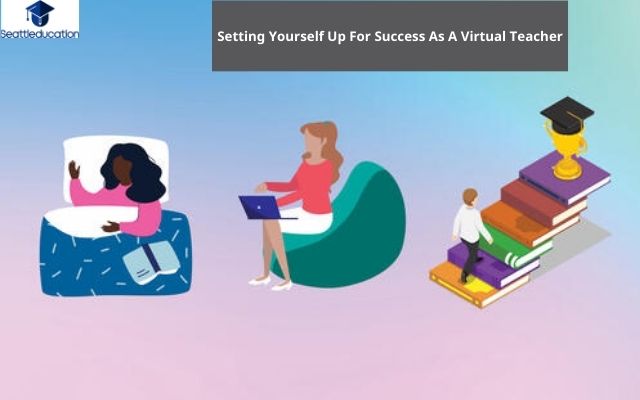Virtual Teaching Positions: Opportunities & Challenges 2023
Virtual Teaching Positions are becoming increasingly popular as technology advances and the need for remote work grows. With virtual teaching, educators can collaborate with students from around the world without ever needing to leave their homes. This article will discuss how these positions have become more prevalent in recent years and explore what it takes to be successful in this type of job.
Let’s get started!
Benefits Of Virtual Teaching
The benefits of virtual teaching are plentiful. One major benefit is scheduling flexibility, as teachers can set a schedule that works for them and their students; this allows for greater engagement among both parties.
Technological literacy is another key advantage to virtual teaching; it requires the teacher to be adept in using digital platforms and software, which ultimately makes them more marketable in today’s job climate.
Lastly, time management plays an essential role in successful virtual teaching. Being able to effectively manage one’s workload while also providing quality instruction results in greater efficiency and output overall. All these factors combine to make virtual teaching a highly attractive option for many educators.
To summarize, virtual teaching provides many opportunities not available with traditional methods due to its emphasis on scheduling flexibility, technological literacy, and effective time management skills, allowing educators to reach and engage with students in a variety of ways.
Challenges Of Virtual Teaching
The virtual classroom is a different world than the traditional one. It takes skill and patience to create an immersive learning experience while navigating technology and connecting with students through a computer screen.
Teaching virtually comes with unique challenges, such as creating virtual engagement, which can be difficult when you don’t have the same physical proximity of in-person teaching. One way to foster student engagement remotely is by utilizing interactive tools like polls or breakout rooms that allow for discussion among small groups of learners.

Encouraging creativity is another tactic – having students design projects or engage in roleplaying activities gives them ownership over their learning experience and encourages collaboration between classmates. Additionally, allowing plenty of time for questions & answers sessions helps teachers make sure everyone understands the material covered during class.
Teachers must also prioritize building trust and connection online without relying solely on communication tools. Incorporating icebreakers into lessons breaks up monotony and allows teachers to get to know their students better – it’s important to remember that the relationships forged in this new environment will require deliberate effort from both parties involved.
By approaching each lesson with intentionality, educators are able to build strong rapport with their students even at a distance.
Qualifications For Virtual Teaching
Being a virtual teacher is no small feat. It requires an array of qualifications to ensure students are supported and given the best possible educational experience in their virtual classrooms. Here are some key qualifications that all aspiring virtual teachers should possess:

– Technology Requirements: Virtual teaching necessitates being comfortable with technology, from video conferencing platforms like Zoom or Skype, to virtual whiteboard software such as Awebber or Miro, it’s important for online educators to have a good working knowledge of common teaching tools used in the digital classroom.
– Virtual Classrooms: The ability to set up and manage a cohesive learning environment within the confines of cyberspace is also essential; this includes setting up breakout rooms, uploading resources/files into one central location, managing student engagement throughout class time and more.
– Teaching Strategies: Finally, having a broad understanding of different pedagogical approaches can be useful when adapting content for the cyber-schoolroom. From inquiry based instruction to flipped classrooms, incorporating new strategies while keeping in mind how these will translate over various mediums will help maximize student performance regardless of platform.
In short, possessing high levels of technological literacy along with creative problem solving skills and solid instructional strategies makes for successful online instructors who can create dynamic experiences for students even without face-to-face contact.
Types Of Virtual Teaching Positions
The world of virtual teaching is rapidly expanding with the rise of distance learning. There are a variety of positions available to educators in this field, each requiring different skillsets and using unique approaches to instruction. These include synchronous instruction, asynchronous instruction, as well as other methods such as online tutoring.
Synchronous instruction involves real-time communication between teachers and students through video conferencing platforms or live classes held over the internet. This type of teaching requires excellent organizational skills and an ability to think quickly on one’s feet while engaging with learners virtually.
Asynchronous instruction is more flexible; it typically involves pre-recorded materials that can be accessed by the student at any time from anywhere in the world. Educators who specialize in this method need strong written communication abilities and must be comfortable creating resources for their students ahead of time.
Other types of virtual teaching roles may involve providing one-on-one support to students via online tutoring services. Here, instructors have the chance to work closely with individual learners and customize assessments and activities accordingly — providing valuable mentorship opportunities along the way.
Finding Virtual Teaching Positions
Finding virtual teaching positions is becoming increasingly popular as more and more schools look to adapt remote learning environments. With the proper resources, qualifications, and motivation, anyone can become a successful online teacher or tutor.
Here are just some of the ways that one can begin their search:
- Start by researching online tutoring companies. These organizations often have opportunities for certified teachers to develop curriculums and lead classes virtually in various subjects.
- Network with industry professionals who specialize in virtual classrooms and technology-based instruction. They may be able to direct you toward potential openings at specific companies or institutions.
- Contact local school districts directly to inquire about any available positions they might have open for remote instructors.
- Take advantage of job boards dedicated to connecting educators with employers looking for qualified individuals to fill virtual teaching roles.
With all these options available, it’s easy to see how digital education has become so prevalent today. By leveraging the right resources, anybody can find success as an online educator!
Preparing For Virtual Teaching Interviews
The job interview process can be intimidating, but with the right preparation, you will be able to confidently demonstrate your suitability for a virtual teaching position. It is important to familiarize yourself with the industry’s standards and expectations when it comes to interview etiquette and remote communication. To help you get ready for your upcoming virtual teaching interviews, here are some key tips:
| Interview Tips | Virtual Etiquette | Remote Communication |
| Dress professionally | Speak clearly and politely | Utilize video conferencing tools |
| Be punctual | Respect time differences | Follow up promptly |
| Listen actively | Demonstrate positive attitude | Use audio-visual aids |
| Ask questions | Show enthusiasm | Reply to emails immediately |
Being aware of these guidelines in advance will give you an edge over other candidates during the hiring process. Researching potential employers, determining their specific needs, preparing thoughtful answers ahead of time, and bringing examples that highlight your qualifications are all great ways to set yourself apart from others on this competitive path.
With proper preparation, practice and confidence in hand, there’s no reason why one should not make a strong impression in their virtual teaching interviews.
Negotiating Salary For Virtual Teaching Positions
Negotiating salary for virtual teaching positions is an important step in the process of becoming a successful remote educator. To ensure that educators receive adequate and fair compensation, it is essential to understand the basics of online pedagogy, create a favorable impression during negotiations with employers, and be confident in your worth.
When negotiating salaries for virtual teaching positions, there are several key elements to consider:
- Researching current market conditions related to remote learning
- Understanding employer expectations regarding online classrooms and instruction
- Being mindful of what you can offer as a teacher compared to other candidates
- Establishing realistic goals based on your qualifications
Ultimately, success when negotiating salaries for virtual teaching roles will come from preparation and self-confidence. Knowing what you bring to the table will help you secure fair pay while making sure you’re able to meet employer needs.
With this knowledge and these strategies, educators can be well equipped to approach remote teaching opportunities with confidence knowing they have done their due diligence in securing a satisfactory rate of compensation.
Setting Yourself Up For Success As A Virtual Teacher
The world of virtual teaching is a vibrant and ever-changing one. It requires teachers to quickly adapt their approaches in order to deliver effective lessons and manage virtual classrooms successfully. Crafting effective lessons, managing virtual classrooms, and utilizing technology tools are all essential components for setting yourself up for success as a virtual teacher.

First off, it’s important to create engaging lesson plans that cater specifically to the needs of each student or group you teach. This means being flexible with your approach – using different tactics depending on the learning style of your students. You also need to be able to break down complex topics into smaller parts while making sure they understand the information presented.
When leading class sessions online, it’s essential to use various techniques such as polls, breakout rooms, webinars, etc., in order to maintain student engagement and promote active participation during class time. Additionally, having clear guidelines set forth from the beginning will help streamline communication between you and your students which can foster an environment conducive for learning.
Finally, incorporating technology tools like video conferencing platforms into classroom activities can make them more interactive and interesting for both you and your learners alike.
Overall, by understanding how to craft effective lessons, effectively manage virtual classrooms, and utilize available technology tools accordingly – teachers can ensure successful outcomes for themselves as well as their students when teaching virtually.
Conclusion
In conclusion, becoming a virtual teacher is certainly an attractive option for those with the right skills and experience. It can be a great way to make money while avoiding long commutes or dealing with difficult classrooms. With the right equipment and knowledge of best practices, anyone can become a successful virtual teacher.
I highly recommend researching this field further if you’re considering it as a career path – it may be just what you need!






